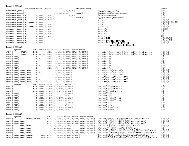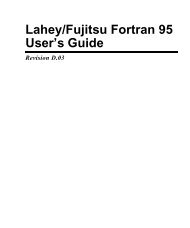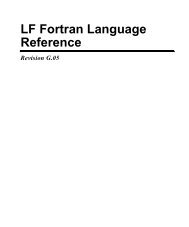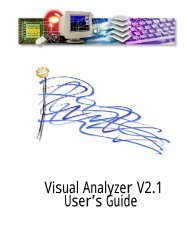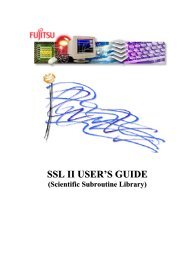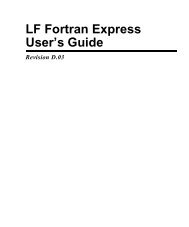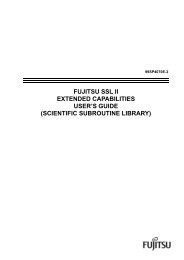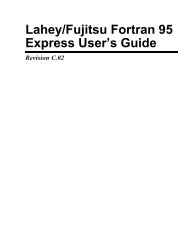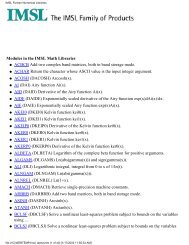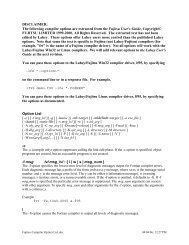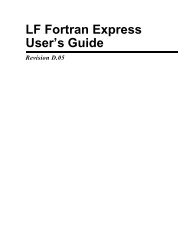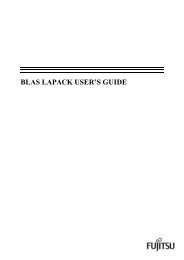- Page 1 and 2: SSL II USER’S GUIDE (Scientific S
- Page 3 and 4: This document contains technology r
- Page 6 and 7: CONTENTS SSL II SUBROUTINE LIST....
- Page 8: 11.3 Exponential Integral .........
- Page 11 and 12: Linear equations 2 Subroutine name
- Page 13 and 14: Eigenvalues 4 Subroutine name Item
- Page 15 and 16: Approximation 6 Subroutine name Ite
- Page 17 and 18: Numerical Quadrature 8 Subroutine n
- Page 19: J. Pseudo Random Numbers 10 Subrout
- Page 23 and 24: 14 Symbol Example Meaning Remarks
- Page 26 and 27: CHAPTER 1 SSL II OUTLINE 1.1 BACKGR
- Page 28 and 29: CHAPTER 2 GENERAL RULES 2.1 TYPES O
- Page 30 and 31: ( , , , , , , , , Output parameters
- Page 32 and 33: a ij ⎧1, ⎪ = ⎨0, ⎪ ⎩0, j
- Page 34 and 35: ⎡a11 a12 a13 a14 a15 ⎤ ⎢ a a
- Page 36 and 37: 2.9 UNIT ROUND OFF SSL II subroutin
- Page 38 and 39: Table 3.3 Subroutines for matrix ma
- Page 40 and 41: Table 3.4 Standard and component ro
- Page 42 and 43: Table 3.6 Subroutines for m × n ma
- Page 44 and 45: CHAPTER 4 EIGENVALUES AND EIGENVECT
- Page 46 and 47: Table 4.3 Subroutines used for stan
- Page 48 and 49: Obtaining selected eigenvalues Sele
- Page 50 and 51: storage mode. (For details, see Sec
- Page 52 and 53: Further, 1) obtains the largest (or
- Page 54 and 55: : CALL GSEG2(A,B,N,N,EPSZ,EPST,E,EV
- Page 56 and 57: convergence, it is assumed that the
- Page 58 and 59: CHAPTER 6 EXTREMA 6.1 OUTLINE The f
- Page 60 and 61: , where ε is a convergence criteri
- Page 62 and 63: A, c, and constant term d. SSL II p
- Page 64 and 65: CHAPTER 7 INTERPOLATION AND APPROXI
- Page 66 and 67: t -k+1 x 0 t-1 t0 x 1 t 1 Fig. 7.1
- Page 68 and 69: The coefficients cj in Equation (7.
- Page 70 and 71:
Table 7.1 Interpolation subroutines
- Page 72 and 73:
CHAPTER 8 TRANSFORMS 8.1 OUTLINE Th
- Page 74 and 75:
Subroutines (component routines) ar
- Page 76 and 77:
Then, Euler transformation is appli
- Page 78 and 79:
Rational function γ 0 is required
- Page 80 and 81:
Table 9.1 Subroutine used for numer
- Page 82 and 83:
abscissas densely where integrand c
- Page 84 and 85:
CHAPTER 10 DIFFERENTIAL EQUATIONS 1
- Page 86 and 87:
2 1 0 -1 y 1 Fig. 10.2 Graph for th
- Page 88 and 89:
Table 11.1 Elliptic integral subrou
- Page 90 and 91:
CHAPTER 12 PSEUDO RANDOM NUMBERS 12
- Page 92:
PART II USAGE OF SSL II SUBROUTINES
- Page 95 and 96:
AKHER E11-11-0201 AKHER, DAKHER Ait
- Page 97 and 98:
AKHER 88 yi, i' ≡ yi + yi′ i yi
- Page 99 and 100:
AKLAG 90 D l ≤ Dl + 1 (3.2) and Z
- Page 101 and 102:
AKMID 92 subroutines BIFD3 or BIFD1
- Page 103 and 104:
AKMID c-11 = 3c11 - 2c21 c01 = 2c11
- Page 105 and 106:
AKMIN (b) Si (x) is determined unde
- Page 107 and 108:
ALU A22-11-0202 ALU, DALU LU-decomp
- Page 109 and 110:
AQC8 G23-11-0301 AQC8, DAQC8 Integr
- Page 111 and 112:
AQC8 Fig. AQC8-1 Data points used b
- Page 113 and 114:
AQC8 Procedure 5 ... ak and Al,k Af
- Page 115 and 116:
AQE G23-11-0401 AQE,DAQE Integratio
- Page 117 and 118:
AQE Method This subroutine uses the
- Page 119 and 120:
AQEH G23-21-10101 AQEH, DAQEH Integ
- Page 121 and 122:
AQEI G23-31-0101 AQEI, DAQEI Integr
- Page 123 and 124:
AQEI which is determined by the beh
- Page 125 and 126:
AQMC8 Table AQMC8-1 - continued 116
- Page 127 and 128:
AQMC8 Furthermore, define x3 i wher
- Page 129 and 130:
AQMC8 where, ~ g , and ~ h , and ~
- Page 131 and 132:
AQME Comments on use • Subprogram
- Page 133 and 134:
AQME 124 NMIN=20 NMAX=705 M=3 CALL
- Page 135 and 136:
AQN9 G23-11-0201 AQN9, DAQN9 Integr
- Page 137 and 138:
AQN9 Procedure 4 ... Detection of i
- Page 139 and 140:
AQN9 130 Order p of the irregular p
- Page 141 and 142:
ASVD1 A25-31-0201 ASVD1, DASVD1 Sin
- Page 143 and 144:
ASVD1 134 P = I − x x , k = 1,...
- Page 145 and 146:
BDLX A52-31-0302 BDLX, DBDLX A syst
- Page 147 and 148:
BICD1 E12-32-1102 BICD1, DBICD1 B-s
- Page 149 and 150:
BICD1 as (nx+m − 1) systems of li
- Page 151 and 152:
BICD3 Table BICD3-1 Condition codes
- Page 153 and 154:
BIC1 where, Nj,m+1(x) is the m-th d
- Page 155 and 156:
BIC2 where, Nj,m+1(x) is the m-th d
- Page 157 and 158:
BIC3 148 1.0 x1 ξ1 t1 t0 t−1 t
- Page 159 and 160:
BIC4 150 j = c j+ −1 , j = −m +
- Page 161 and 162:
BIFD1 VW .... Work area. One-dimens
- Page 163 and 164:
BIFD3 E11-32-3301 BIFD3, DBIFD3 B-s
- Page 165 and 166:
BIF1 E11-31-0101 BIF1, DBIF1 B-spli
- Page 167 and 168:
BIF2 E11-31-0201 BIF2, DBIF2 B-spli
- Page 169 and 170:
BIF3 E11-31-0301 BIF3, DBIF3 B-spli
- Page 171 and 172:
BIF4 E11-31-0401 BIF4, DBIF4 B-spli
- Page 173 and 174:
BIN I11-81-1201 BIN, DBIN Integer o
- Page 175 and 176:
BIR I11-83-0301 BIR, DBIR Real orde
- Page 177 and 178:
BI1 I11-81-0701 BI1,DBI1 First orde
- Page 179 and 180:
BJN The value of Jn(x) is computed
- Page 181 and 182:
BJR • 0≤x0.115x+4 Double precis
- Page 183 and 184:
BJ0 Double precision: 174 5 2k () x
- Page 185 and 186:
BJ1 Double precision: 176 5 2k () x
- Page 187 and 188:
BKR I11-83-0401 BKR, DBKR Real orde
- Page 189 and 190:
BKR the value of Kv(x) can be compu
- Page 191 and 192:
BK0 I11-81-0801 BK0, DBK0 Zero orde
- Page 193 and 194:
BLNC B21-11-0202 BLNC, DBLNC Balanc
- Page 195 and 196:
BLUX1 A52-11-0302 BLUX1, DBLUX1 A s
- Page 197 and 198:
BLUX1 where Mk is the following mat
- Page 199 and 200:
BLU1 coefficient matrix, multiplied
- Page 201 and 202:
BMDMX A52-21-0302 BMDMX, DBMDMX A s
- Page 203 and 204:
BSCD2 E32-32-0202 BSCD2, DBSCD2 B-s
- Page 205 and 206:
BSCD2 C **EXAMPLE** DIMENSION X(80)
- Page 207 and 208:
BSCT1 B21-21-0502 BSCT1, DBSCT1 Sel
- Page 209 and 210:
BSCT1 In this case, bisection of th
- Page 211 and 212:
BSC1 ill-conditioned as m becomes l
- Page 213 and 214:
BSC2 • Notes By calling subroutin
- Page 215 and 216:
BSEG B51-21-0201 BSEG, DBSEG Eigenv
- Page 217 and 218:
BSEGJ B51-21-1001 BSEGJ, DBSEGJ Eig
- Page 219 and 220:
BSEGJ corresponding eigenvectors pi
- Page 221 and 222:
BSEGJ 212 n ∑ j= 1 ( k ) k x = x
- Page 223 and 224:
BSFD1 E-31-32-0101 BSFD1, DBSFD1 B-
- Page 225 and 226:
BSF1 E31-31-0101 BSF1, DBSF1 B-spli
- Page 227 and 228:
BSVEC B51-21-0402 BSVEC, DBSVEC Eig
- Page 229 and 230:
BSVEC The right hand side of Eq. (4
- Page 231 and 232:
BTRID associated with the h-th and
- Page 233 and 234:
BYR I11-83-0201 BYR, DBYR Real orde
- Page 235 and 236:
BYR x≤3.66 (4.15) is found to be
- Page 237 and 238:
BY0 I11-81-0401 BY0, DBY0 Zero orde
- Page 239 and 240:
BY1 I11-81-0501 BY1, DBY1 First ord
- Page 241 and 242:
CBIN I11-82-1101 CBIN, DCBIN Intege
- Page 243 and 244:
CBJR I11-84-0101 CBJR, DCBJR Real o
- Page 245 and 246:
CBKN I11-82-1201 CBKN, DCBKN Intege
- Page 247 and 248:
CBKN ~ 2 H i ( m, n) = H i ( m, n)
- Page 249 and 250:
CBLNC 240 ⎡ ( s) d ⎤ 1 0 ⎢ (
- Page 251 and 252:
CEIG2 B21-15-0101 CEIG2, DCEIG2 Eig
- Page 253 and 254:
CELI1 I11-11-0101 CELI1, DCELI1 Com
- Page 255 and 256:
CFRI I11-51-0201 CFRI, DCFRI Cosine
- Page 257 and 258:
CFT 248 N1 x 0,0 x 1,0 x N1-1,0 x 0
- Page 259 and 260:
CFTM F12-11-0101 CFTM, DCFTM Multi-
- Page 261 and 262:
CFTM 252 (b) For three-variate tran
- Page 263 and 264:
CFTN F12-15-0202 CFTN, DCFTN Discre
- Page 265 and 266:
CFTN C **EXAMPLE** DIMENSION A(1024
- Page 267 and 268:
CFTN 258 α 1 ⎛ j k ⎞ ⎛ j k
- Page 269 and 270:
CFTR x 260 J1, J 2 = N1−1 N 2−1
- Page 271 and 272:
CFTR multiplication is necessary, a
- Page 273 and 274:
CGSM A11-10-0101 CGSM, DCGSM Storag
- Page 275 and 276:
CHBK2 B21-15-0602 CHBK2, DCHBK2 Bac
- Page 277 and 278:
CHES2 B21-15-0302 CHES2, DCHES2 Red
- Page 279 and 280:
CHSQR B21-15-0402 CHSQR, DCHSQR Eig
- Page 281 and 282:
CHVEC B21-15-0502 CHVEC,DCHVEC Eige
- Page 283 and 284:
CHVEC where u is the unit round-off
- Page 285 and 286:
CJART 276 ( z2 − z3 )( z3 − z1)
- Page 287 and 288:
CLU C **EXAMPLE** DIMENSION ZA(100,
- Page 289 and 290:
CLUIV Method The subroutine compute
- Page 291 and 292:
CLUX 282 500 FORMAT(I5) 510 FORMAT(
- Page 293 and 294:
CNRML 284 y = x i i x i ∞ , x i
- Page 295 and 296:
CQDR C21-15-0101 CQDR, DCQDR Zeros
- Page 297 and 298:
CSBGM The lower triangular portion
- Page 299 and 300:
CSGM A11-10-0201 CSGM, DCSGM Storag
- Page 301 and 302:
CTSDM C23-15-0101 CTSDM, DCTSDM Zer
- Page 303 and 304:
ECHEB B51-30-0201 ECHEB, DECHEB Eva
- Page 305 and 306:
ECOSP E51-10-0201 ECOSP, DECOSP Eva
- Page 307 and 308:
EIG1 B21-11-0101 EIG1, DEIG1 Eigenv
- Page 309 and 310:
EIG1 • Reduction of a real Hessen
- Page 311 and 312:
ESINP E51-20-0201 ESINP, DESINP Eva
- Page 313 and 314:
EXPI I11-31-0101 EXPI, DEXPI 304 Ex
- Page 315 and 316:
FCHEB E51-30-0101 FCHEB, DFCHEB Che
- Page 317 and 318:
FCHEB 308 IF(ICON.GT.10000) GOTO 10
- Page 319 and 320:
FCHEB 310 ⎧⎛ ⎪⎜ ⎪⎜ c
- Page 321 and 322:
FCOSF E51-10-0101 FCOSF, DFCOSF Cos
- Page 323 and 324:
FCOSF 314 See Example 2. • Exampl
- Page 325 and 326:
FCOSF periodic function its series
- Page 327 and 328:
FCOSM F11-11-0201 FCOSM, DFCOSM Dis
- Page 329 and 330:
FCOSM Symmetric property: x 320 p
- Page 331 and 332:
FCOST • Example (a) By inputting
- Page 333 and 334:
FSINF E51-20-0101 FSINF, DFSINF Sin
- Page 335 and 336:
FSINF The theoretical sine series e
- Page 337 and 338:
FSINF If r is greater than 0.99, th
- Page 339 and 340:
FSINM F11-21-0201 FSINM, DFSINM Dis
- Page 341 and 342:
FSINM Initial value 0 ⎛ π ⎛ 1
- Page 343 and 344:
FSINT READ(5,500) N,(X(I),I=1,N) WR
- Page 345 and 346:
GBSEG • Notes When eigenvalues ar
- Page 347 and 348:
GBSEG is satisfied. If this converg
- Page 349 and 350:
GCHEB 340 600 FORMAT('0',3X,'EXPANS
- Page 351 and 352:
GINV 342 AXA = A XAX = X ⎫ ⎪
- Page 353 and 354:
GSBK 344 500 FORMAT(2I5,2E15.7) 510
- Page 355 and 356:
GSCHL 346 WRITE(6,600) N,M,EPSZ,EPS
- Page 357 and 358:
GSEG2 are upper and lower limits, r
- Page 359 and 360:
HAMNG H11-20-0121 HAMNG, DHAMNG A s
- Page 361 and 362:
HAMNG where, n1 depends on the elem
- Page 363 and 364:
HBK1 B21-11-0602 HBK1, DHBK1 Back t
- Page 365 and 366:
HEIG2 B21-25-0201 HEIG2, DHEIG2 Eig
- Page 367 and 368:
HES1 B21-11-0302 HES1,DHES1 Reducti
- Page 369 and 370:
HRWIZ F20-02-0201 HRWIZ,DHRWIZ Judg
- Page 371 and 372:
HSQR The left side of (4.4) is alwa
- Page 373 and 374:
HVEC eigenvectors is larger than th
- Page 375 and 376:
HVEC 366 if λ j = λi then from (4
- Page 377 and 378:
ICHEB 368 1 1 −1 f () x = + tan 1
- Page 379 and 380:
IERFC I11-71-0401 IERFC,DIERFC Inve
- Page 381 and 382:
IGAM1 I11-61-0101 IGAM1, DIGAM1 Inc
- Page 383 and 384:
IGAM2 374 ∫ ∞ 0 −x −t v−m
- Page 385 and 386:
INDFC I11-91-0401 INDFC, DINDFC Inv
- Page 387 and 388:
INSPL Where S0(x) and Sn(x) are pol
- Page 389 and 390:
LAPS1 • Example Given a rational
- Page 391 and 392:
LAPS2 382 () () F () s Fs () Qs = =
- Page 393 and 394:
LAPS3 An example of the above proce
- Page 395 and 396:
LAPS3 C **EXAMPLE** DIMENSION FT(80
- Page 397 and 398:
LAX A22-11-0101 LAX, DLAX A system
- Page 399 and 400:
LAXL A25-11-0101 LAXL, DLAXL Least
- Page 401 and 402:
LAXL • Previous to the k -th tran
- Page 403 and 404:
LAXLM • Example This example show
- Page 405 and 406:
LAXLM When ISW=0, this subroutine d
- Page 407 and 408:
LAXLR 398 CALL PGM(NT1,6,A,50,M,N)
- Page 409 and 410:
LAXR puts it to work area VW(1) wit
- Page 411 and 412:
LBX1 A52-11-0101 LBX1,DLBX1 A syste
- Page 413 and 414:
LBX1R A52-11-0401 LBX1R, DLBX1R Int
- Page 415 and 416:
LBX1R where x (s) is the s-th appro
- Page 417 and 418:
LCX 408 M=M+1 ISW=2 GOTO 10 20 ZDET
- Page 419 and 420:
LCXR subroutine LCX can be obtained
- Page 421 and 422:
LDIV A22-51-0702 LDIV, DLDIV The in
- Page 423 and 424:
LDLX A22-51-0302 LDLX, DLDLX A syst
- Page 425 and 426:
LESQ1 E21-20-0101 LESQ1, DLESQ1 Pol
- Page 427 and 428:
LMINF D11-30-0101 LMINF, DLMINF Min
- Page 429 and 430:
LMING D11-40-0101 LMING, DLMING Min
- Page 431 and 432:
LMING Step 2 (cubic interpolation)
- Page 433 and 434:
LOWP 424 = x 2 + h (4.4) xa m (b) W
- Page 435 and 436:
LPRS1 NBV .. Input. (When ISW = 10
- Page 437 and 438:
LPRS1 Method First, the following s
- Page 439 and 440:
LPRS1 corresponding to a slack vari
- Page 441 and 442:
LSBIX For the method to obtain the
- Page 443 and 444:
LSBX • Example l systems of linea
- Page 445 and 446:
LSBXR LSBX, then it is iteratively
- Page 447 and 448:
LSIX A22-21-0101 LSIX,DLSIX 438 A s
- Page 449 and 450:
LSIXR A22-21-0401 LSIXR, DLSIXR 440
- Page 451 and 452:
LSTX A52-31-0501 LSTX, DLSTX A syst
- Page 453 and 454:
LSTX 444 d n−i+ 1 = an−i+ 1, n
- Page 455 and 456:
LSX 446 WRITE(6,610) ICON IF(ICON.G
- Page 457 and 458:
LSXR 448 IF(N.EQ.0) STOP NT=N*(N+1)
- Page 459 and 460:
LTX With ISW=2, the calculation tim
- Page 461 and 462:
LUIV A22-11-0602 LUIV, DLUIV 452 Th
- Page 463 and 464:
LUX A22-11-0302 LUX, DLUX 454 A sys
- Page 465 and 466:
MAV A21-13-0101 MAV, DMAV 456 Multi
- Page 467 and 468:
MBV A51-11-0101 MBV, DMBV 458 Multi
- Page 469 and 470:
MCV A21-15-0101 MCV, DMCV 460 Multi
- Page 471 and 472:
MDMX A22-21-0302 MDMX, DMDMX 462 A
- Page 473 and 474:
MGGM A21-11-0301 MGGM, DMGGM Multip
- Page 475 and 476:
MINF1 D11-10-0101 MINF1, DMINF1 466
- Page 477 and 478:
MINF1 468 ( g g ) = B ( x − x ) k
- Page 479 and 480:
MING1 D11-20-0101 MING1, DMING1 470
- Page 481 and 482:
MING1 must be satisfied. • Comput
- Page 483 and 484:
MSBV A51-14-0101 MSBV, DMSBV 474 Mu
- Page 485 and 486:
MSGM A-21-12-0401 MSGM, DMSGM 476 M
- Page 487 and 488:
MSV A21-14-0101 MSV, DMSV 478 Multi
- Page 489 and 490:
NDF I11-91-0101 NDF, DNDF 480 Norma
- Page 491 and 492:
NLPG1 D31-20-0101-NLPG1, DNLPG1 482
- Page 493 and 494:
NLPG1 C JACOBIAN SUBROUTINE JAC(X,C
- Page 495 and 496:
NLPG1 486 If z ≥ ε and if ( 1. 0
- Page 497 and 498:
NOLBR [The meaning of FC] Sometimes
- Page 499 and 500:
NOLF1 D15-10-0101 NOLF1, DNOLF1 Min
- Page 501 and 502:
NOLF1 492 ( ) − ∇F xk is the di
- Page 503 and 504:
NOLG1 D15-20-0101 NOLG1, DNOLG1 494
- Page 505 and 506:
NOLG1 The value of k x ∆ which mi
- Page 507 and 508:
NRML B21-11-0702 NRML, DNRML 498 No
- Page 509 and 510:
ODAM H11-20-0141 ODAM, DODAM A syst
- Page 511 and 512:
ODAM If the maximum accuracy attain
- Page 513 and 514:
ODAM * k, m P * k, m P 504 ( x ) m+
- Page 515 and 516:
ODAM P 506 In obtaining the solutio
- Page 517 and 518:
ODAM then ERR is defined as 508 ERR
- Page 519 and 520:
ODGE 510 “Comments on Use” for
- Page 521 and 522:
ODGE indicating that the user’s r
- Page 523 and 524:
ODGE 514 This is referred to as the
- Page 525 and 526:
ODGE 516 ( x ) = f ( x y ) m′ m+
- Page 527 and 528:
ODRK1 H11-20-0131 ODRK1, DODRK1 A s
- Page 529 and 530:
ODRK1 520 IF(ICON.EQ.16000) GO TO 6
- Page 531 and 532:
PNR F12-15-0402 PNR, DPNR 522 Permu
- Page 533 and 534:
PNR (c) Permutation after a two-var
- Page 535 and 536:
RANB2 1.0 0.7 0.5 −1 0 1 2 3 4 5
- Page 537 and 538:
RANN1 J11-20-0301 RANN1 528 Fast no
- Page 539 and 540:
RANN2 J11-20-0101 RANN2 530 Generat
- Page 541 and 542:
RANP2 532 Refer to the example in R
- Page 543 and 544:
RANU2 IF(X.LT.BK) GO TO 20 IF(X.LT.
- Page 545 and 546:
RANU3 J11-10-0201 RANU3 536 Generat
- Page 547 and 548:
RATF1 J21-10-0101 RATF1 Frequency t
- Page 549 and 550:
RATR1 J21-10-0201 RATR1 540 Runs te
- Page 551 and 552:
RATR1 and the total sum is 542 ∑
- Page 553 and 554:
RFT C **EXAMPLE** DIMENSION A(1024)
- Page 555 and 556:
RJETR C22-11-0111 RJETR, DRJETR Zer
- Page 557 and 558:
RJETR the process (4.2) is iterated
- Page 559 and 560:
RKG H11-20-0111 RKG, DRKG 550 A sys
- Page 561 and 562:
RQDR C21-11-0101 RQDR, DRQDR 552 Ze
- Page 563 and 564:
SBDL C **EXAMPLE** DIMENSION A(3825
- Page 565 and 566:
SBMDM The transposition vector is c
- Page 567 and 568:
SEIG1 B21-21-0101 SEIG1, DSEIG1 558
- Page 569 and 570:
SEIG2 B21-21-0201 SEIG2, DSEIG2 560
- Page 571 and 572:
SFRI I11-51-0101 SFRI, DSFRI 562 Si
- Page 573 and 574:
SIMP1 G21-11-0101 SIMP1, DSIMP1 Int
- Page 575 and 576:
SIMP2 many points where the integra
- Page 577 and 578:
SIMP2 than necessary. Some devices
- Page 579 and 580:
SLDL A22-51-0202 SLDL, DSLDL 570 LD
- Page 581 and 582:
SMDM A22-21-0202 SMDM, DSMDM 572 MD
- Page 583 and 584:
SMDM (a) 574 s ik i = d i, i− 1 q
- Page 585 and 586:
SMLE1 Method This subroutine smooth
- Page 587 and 588:
SMLE2 points, instead of fitting a
- Page 589 and 590:
SPLV 580 CALL SPLV(X,Y,N,ISW,DY,V,M
- Page 591 and 592:
SSSM A21-12-0201 SSSM, DSSSM 582 Su
- Page 593 and 594:
TEIG1 584 T = Q T Q , s = 1, 2, 3,.
- Page 595 and 596:
TEIG2 matrix T are 586 λ > 1 > λ2
- Page 597 and 598:
TRAP G21-21-0101 TRAP, DTRAP 588 In
- Page 599 and 600:
TRBK 590 T T T Pn −2 ⋅ ⋅ ⋅
- Page 601 and 602:
TRBKH 592 500 FORMAT(2I5) 510 FORMA
- Page 603 and 604:
TRIDH Comments on use • Subprogra
- Page 605 and 606:
TRID1 B21-21-0302 TRID1, DTRID1 596
- Page 607 and 608:
TRQL B21-21-0402 TRQL, DTRQL Eigenv
- Page 609 and 610:
TRQL 600 () s P T n−1 where, C S
- Page 611 and 612:
TSDM • Example A root of f(x) = e
- Page 613 and 614:
TSD1 C23-11-0101 TSD1, DTSD1 604 Ze
- Page 615 and 616:
606 APPENDICES
- Page 617 and 618:
AMACH A.2 AMACH, DMACH Unit round o
- Page 619 and 620:
MGSET A.4 MGSET Control of message
- Page 621 and 622:
CSUM A.6 CSUM, DCSUM Product sum (C
- Page 623 and 624:
AFMAX, AFMIN A.8 AFMAX, DFMAX, AFMI
- Page 625 and 626:
Table B.1 General subroutines Subro
- Page 627 and 628:
B.2 SLAVE SUBROUTINES Table B.2 sho
- Page 629 and 630:
APPENDIX C CLASSIFICATION CODES AND
- Page 631 and 632:
APPENDIX D REFERENCES [1] Forsythe.
- Page 633 and 634:
[53] Carl de Boor. On Calculating w
- Page 635 and 636:
CONTRIBUTORS AND THEIR WORKS Author
- Page 637:
K.Tone LMINF Minimization of functi



